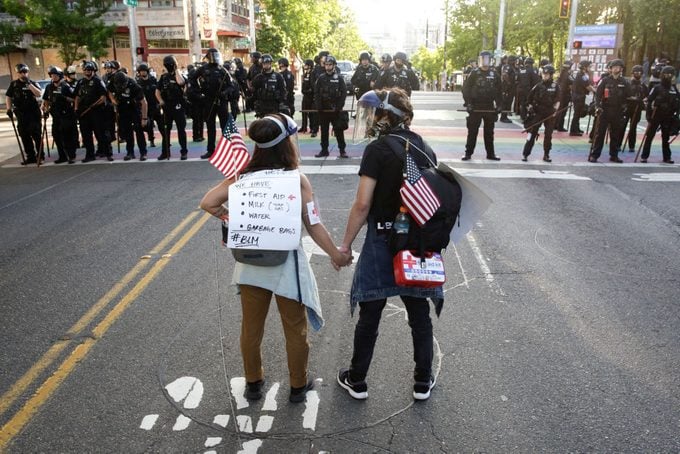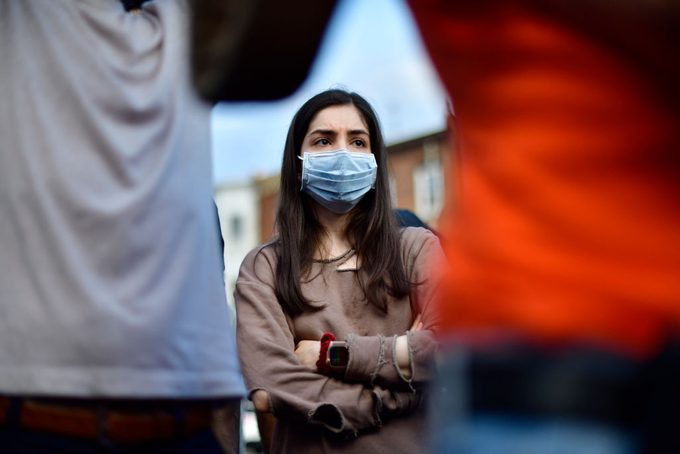First Aid: How to Prepare for Crowds and Protests
Updated: Jun. 08, 2020
Lauren Harris, a veteran of marching and protesting to raise awareness, and other experts offer practical tips that may help you stay safe and hopefully avoid injuries when you're taking to the streets.
Lauren Harris, a New York City mom and yoga instructor, has been marching and protesting to raise awareness for various social justice causes since she was a teen, and she has it pretty much down to a science, starting with her shoes: “You are not going to a protest in high heels or flip-flops with no support. Wear running shoes or hiking boots.”
Harris recently took to the New York City streets to peacefully protest the ongoing issue of police violence and racism, including the treatment of George Floyd, the 46-year-old black man who died in Minneapolis after a white police officer pressed his knee to Floyd’s neck.
Many of these protests, which have taken place across the map, have been upended by violence and looting, which Harris admits has given her pause and encouraged her to take extra precautions.
Of course, the hope is that any protest you attend will be peaceful and your message will be heard, but being prepared can help assure that you stay safe even if violence does erupt, experts agree.

Before the event: Dress appropriately
If you are attending a protest march in warm weather, you may be tempted to dress in light fabrics and shorts. That would be a mistake. The good news is that many of the items you would wear to any protest or march can double as protection against the spread of infectious diseases, which at this time means coronavirus.
Wear a face mask
As coronavirus is still circulating, you should wear a face mask. (Just as you would in any situation where social distancing is difficult.) “Stay mindful of physical distancing whenever possible, wearing a face covering, and staying home when you’re sick is important for your health and that of other demonstrators,” says Russell Buhr, MD, PhD, assistant professor of medicine in the division of pulmonary and critical care at the David Geffen School of Medicine at UCLA in Los Angeles.
Wear goggles or some form of eye protection
Coronavirus can spread through respiratory droplets that can land in the eyes. And although not confirmed, some experts think that aerosolized viral particles landing in your eyes could spread the virus, too. Goggles will offer some protection from the virus, and they also happen to be the best way to protect your eyes from tear gas, pepper spray, and rubber bullets, says Robert Glatter, MD, an emergency physician in New York City. “Goggles can and should be worn over your glasses.”
Wear sensible clothing
Even if the weather is warm, you should don a long-sleeved shirt, long pants made of denim or another durable material, and sturdy shoes—hiking boots or good running shoes—to protect your body as much as possible in case police use tear gas, pepper spray, or rubber bullets to control the crowd, says Dr. Buhr.
Don’t wear jewelry or contact lenses
Necklaces, earrings, and rings can snag on clothing and lead to injuries. You’re better off leaving them at home. Don’t wear contact lenses if you don’t have to, Dr. Buhr says. “The chemicals can get under the lens making it harder to wash out,” he explains. “If you’re wearing contacts and encounter the agents, get the contacts out as soon as possible.”
What to pack for the event
When you plan to attend a protest, vigil, or march, consider putting together your own first aid kit so that you can help yourself and others should someone get injured. Carry these items in a backpack or messenger bag to keep your hands free.
Basic first aid kit
Any packable first aid kit with gauze, medical tape, Band-Aids, and wet wipes, should go in the bag. The other essentials include hand sanitizer, anti-bacterial ointment, and wide gauze rolls, such as Kerlix Bandage Rolls, says Dr. Glatter. “We use these to cover burns or bruises,” he says.
Plenty of water, snacks
Yes, you’ll need to hydrate on a long walk and you could use some calories for sustenance. But you can also use water to wash pepper spray or tear gas out of the eyes. Water is better than milk or baby shampoo, says Dr. Glatter, noting that you need a lot of water to get the job done right. While some people swear by a baking soda-and-water solution, experts worry the powder could further damage the eyes.
A change of clothes
If you get tear gas or pepper spray on your clothing, it can continue to cause irritation until you can get the clothes off. Keep a plastic bag handy to put the contaminated clothes in once you’re able to change—and you can use wet wipes to clean irritated skin.
A bike helmet
You don’t have to wear it, but if people start throwing stones or bricks, you could quickly don it for extra protection. Dr. Glatter says that wearing a helmet also makes sense if you have any orthopedic injuries and are unsteady on your feet.
Medical information and contacts
Keeping some health and emergency contact information with you is extremely helpful to medical staff if you’re brought in injured or ill, Dr. Buhr adds. “This should include who to call, your current major medical problems, medications you take, and allergies to medications.” He suggests writing them out and tucking them in a sealed plastic bag to prevent damage if it gets wet, and keeping this in a pocket or in your shoe if you don’t have pockets. “Some people will also write emergency contact info in permanent marker on their skin so it can’t get separated from them,” he says. “Make sure your emergency contact person knows your health information too and is aware of where you plan to be and check in with them periodically.”
Personal medications
If you have any underlying health issues like diabetes, asthma, or allergies, make sure to have any of the medications or supplies you may need on hand. That could mean a blood sugar monitor, an EpiPen, or an inhaler. “People with asthma, if they choose to attend a protest, should make sure to bring their rescue inhaler and other asthma medications,” Dr. Glatter stresses. And don’t forget your sunscreen.
Remember to bring cash, ID, credit card, and a phone backup battery
You could be out for much longer than you realize, so be sure you have a way to buy more food or get a ride home if necessary, advise experts at Yale University. This can also mean you’ll need more battery power for your phone.
Treating injuries from riot control measures
Common injuries might include scrapes, bumps, and bruises from falling—treating these is relatively straightforward—brush up on your first-aid skills here.
Pepper spray
Pepper spray is a “lachrymatory agent,” which means it irritates your eyes and produces tears. “Pepper spray increases tear production and secretions in the nose and mouth and also can be an irritant to the lungs,” Dr. Glatter says. Try not to swallow pepper spray. “It will make you feel very nauseous, dizzy, and disoriented.” It can also cause burns and a sudden increase in blood pressure, which can lead to a stroke or heart attack, he warns.
- If you get sprayed: Douse your eyes with water immediately afterward, Dr. Glatter advises. Blink a lot to flush out the resin and never rub your eyes as this will make things worse, he says.
Tear gas
Likewise, tear gas can cause tearing and intense pain and burning in the eyes, throat, lungs, and skin, Dr. Glatter explains. The canister containing the gas can cause serious burns and broken bones and other injuries if shot at close ranges. Swallowing tear gas can also lead to nausea and vomiting, and people with asthma or other lung diseases are at higher risk for complications even after a brief exposure.
- If you get sprayed: Get to higher ground and fresh air, as tear gas stays low to the ground. Remove all of your clothing and place it carefully in a plastic bag, the federal Centers for Disease Control and Prevention adds. Wash any tear gas from your skin as quickly as possible with soap and water and rinse your eyes with plain water if they are burning for 10 to 15 minutes. And “never pick up a hot tear gas canister,” Dr. Glatter adds.
Rubber bullets
Rubber bullets can cause fractures, lacerations, and blindness if they strike you in the eye, Dr. Glatter says.
- If you get hit: Clean out cuts, immobilize potential fractures, and seek medical attention as soon as possible.

Always be aware of your surroundings
Keep your head on a swivel when at a protest: Things can change suddenly and violence can erupt in what was once a peaceful march. “If something starts to feel unsafe, walk away,” Harris says. “Always know where you are and how you will get home.” When violence breaks out suddenly, panic can ensue and a main cause of injury can be trampling, Dr. Buhr says. “If things are escalating beyond your comfort level, walk briskly but try not to run, and get out of harm’s way,” he says. “Keep track of those who are with you, and particularly those who are more vulnerable like children, elderly, and those with a disability.”
Go with friends
There’s safety in numbers, experts agree. “Try to never go to a protest alone,” Dr. Glatter says. Harris attended the march for George Floyd with her oldest daughter, Emerson. Harris says she was more concerned about Covid-19 risk than violence. “I packed an extra mask just in case the one I was wearing got damaged,” she says, adding that the overwhelming majority of protesters were also wearing masks and many had extras to give out in case someone needed one.”It was beautiful to see and very much in the spirit of peace and unity.”

